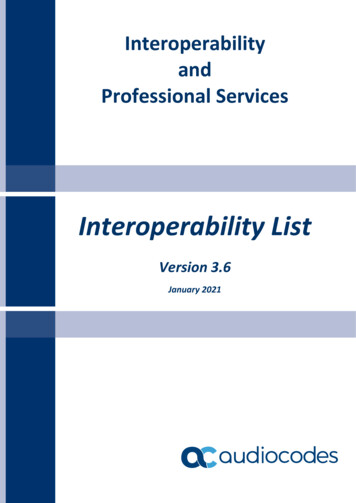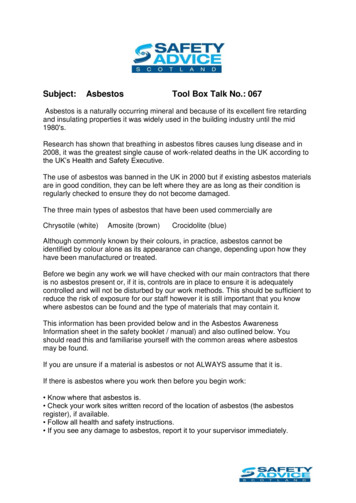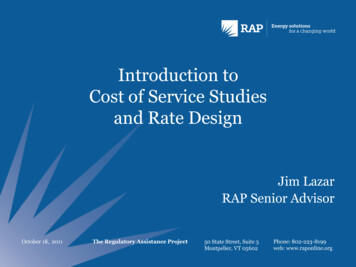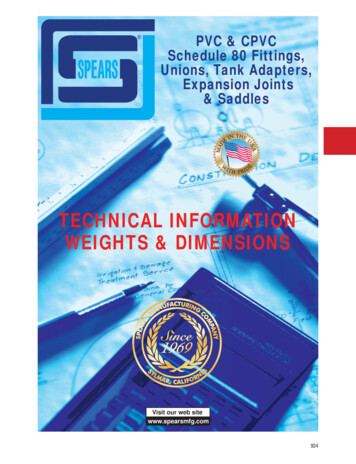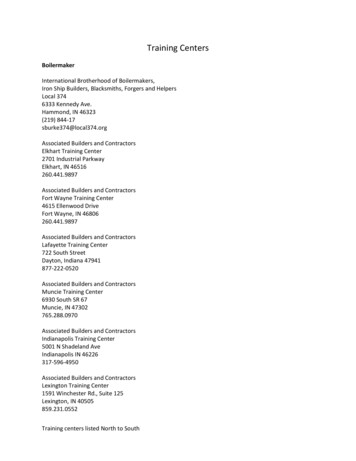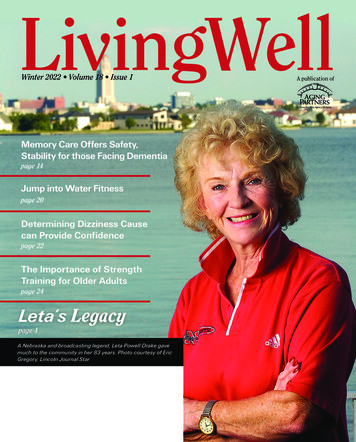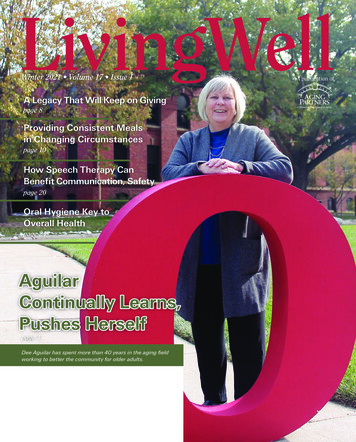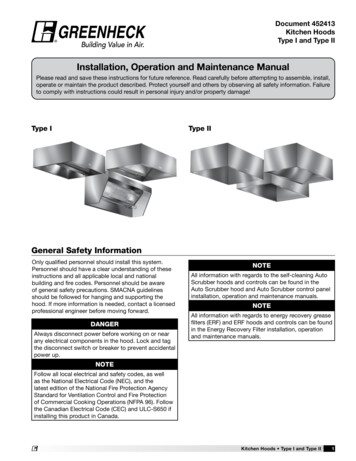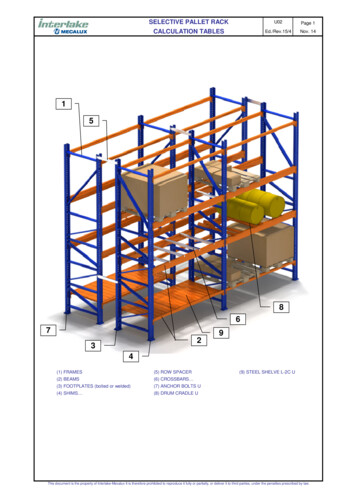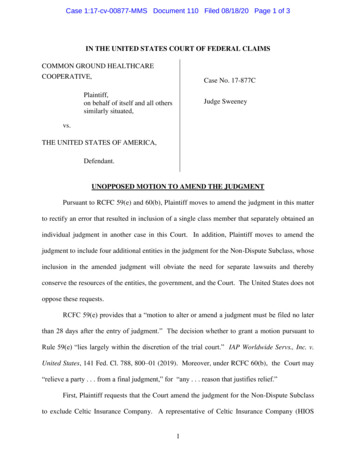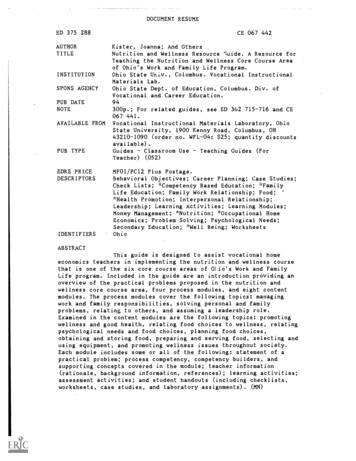
Transcription
DOCUMENT RESUMEED 375 288AUTHORTITLEINSTITUTIONSPONS AGENCYPUB DATENOTECE 067 442Kister, Joanna; And OthersNutrition and Wellness Resource guide. A Resource forTeaching the Nutrition and Wellness Core Course Areaof Ohio's Work and Family Life Program.Ohio State Univ., Columbus. Vocational InstructionalMaterials Lab.Ohio State Dept. of Education, Columbus. Div. ofVocational and Career Education.94300p.; For related guides, see ED 362 715-716 and CE067 441.AVAILABLE FROMPUB TYPEEDRS PRICEDESCRIPTORSIDENTIFIERSVocational Instructional Materials Laboratory, OhioState University, 1900 Kenny Road, Columbus, OH43210-1090 (order no. WFL-04: 25; quantity discountsavailable).Teaching Guides (ForGuidesClassroom UseTeacher) (052)MFO1 /PC12 Plus Postage.Behavioral Objectives; Career Planning; Case Studies;Check Lists; *Competency Based Education; *FamilyLife Education; Family Work Relationship; Food;*Health Promotion; Interpersonal Relationship;Leadership; Learning Activities; Learning Modules;Money Management; *Nutrition; *Occupational HomeEconomics; Problem Solving; Psychological Needs;Secondary Education; *Well Being; WorksheetsOhioABSTRACTThis guide is designed to assist vocational homeeconomics teachers in implementing the nutrition and wellness coursethat is one of the six core course areas of Ohio's Work and FamilyLife program. Included in the guide are an introduction providing anoverview of the practical problems proposed in the nutrition andwellness core course area, four process modules, and eight contentmodules. The process modules cover the following topics: managingwork and family responsibilities, solving personal and familyproblems, relating to others, and assuming a leadership role.Examined in the content modules are the following topics: promotingwellness and good health, relating food choices to wellness, relatingpsychological needs and food choices, planning food choices,obtaining and storing food, preparing and serving food, selecting andusing equipment, and promoting wellness issues throughout society.Each module includes some or all of the following: statement of apractical problem; process competency, competency builders, andsupporting concepts covered in the module; teacher information(rationale, background information, references); learning activities;assessment activities; and student handouts (including checklists,worksheets, case studies, and laboratory assignments). (MN)
:0',NUTRITIONAND WELLNESSRESOURCEGUIDEWork andFamily [lie ProgramU S DEPARTMENT OF EDUCATIONirnaroverwqINFORMATIONED RATIONAL RESOURCESCENTER (ERIC)This document has been reproduced asreceived from the person or organizationOffice or Eclucavonai Resea,ch anti,"PERMISSION TO REPRODUCE THISMATERIAL HAS BEEN GRANTED BYoriginating itID Minor changes have been made toimprove reproduction qualityPoints of view or opinions stated Ir. thisdocument do not necessarily representofficial OERI position or policy//.N// -c(-67TO THE EDUCATIONAL RESOURCESINFORMATION CENTER (ERIC)."CATION.HOME ECONOMICS
Nutrition and Wellness Resource GuideA Resource for Teaching the Nutrition and WellnessCore Course Area ofOhio's Work and Family Life ProgramJoanna Kister, Assistant DirectorOhio Department of EducationDivision of Vocational and Career EducationSandra Laurenson, SupervisorOhio Department of EducationDivision of Vocational and Career EducationHeather BoggsVocational Education ConsultantThe Ohio State University1994Additional copies of this resource guide are available fromThe Ohio State UniversityVocational Instructional Materials Laboratory1900 Kenny RoadColumbus, Ohio 43210-1016(614) 292-4277
This publication was supported by federal funds of Public Law 101-392, the Carl D. Perkins VocationalEducation and Applied Technology Act Amendments of 1990, distributed by the Ohio Department ofEducation, Division of Vocational and Career Education.It is the policy of The Ohio State University to offer educational activities, employment practices, programs,and services without regard to race, color, national origin, sex, religion, handicap, or age.
CONTENTSPrefaceIntroduction1Process ModulesI .Managing Work and Family Responsibilities72. Solving Personal and Family Problems273. Relating to Others574. Assuming a Leadership Role75Content Modules1. Promoting Wellness and Good Health932. Relating Food Choices to Wellness1273. Relating Psychological Needs and Food Choices1654. Planning Food Choices1895. Obtaining and Storing Food2116. Preparing and Serving Food2397. Selecting and Using Equipment2698. Promoting Wellness Issues Throughout Society281
PREFACEThe mission of Ohio vocational home economics programs is to prepare youth and adultsfor the work of the family. The ultimate aim of home economics is to strengthen families,empowering individuals to take action for the well-being of self and others in the home,workplace, community, and world. Our society depends on strong families. Strongfamilies nurture individuals, serve as their first teachers, instill values and standards ofbehavior, and provide human resources for the work force. Unfortunately, statistics withregard to divorce, teen pregnancy, poverty, and family violence suggest that this important institution is in danger. Ohio vocational home economics programs can providemuch needed support for individuals by empowering them to take responsibility for thewell-being of their families.The Ohio Work and Family Life Program is based upon what students need to know, tobe able to do, and to be like in order to be competent in the work of the family. Thecurriculum engages students in practical problem solving, including practical reasoning,to clarify personal and family issues, evaluate alternative choices and their consequences,develop criteria and standards for making ethical choices, and take action based on theconsequences for self, family, and others. The four process skills listed below, which areessential to competence in the work of the family, are taught in each Work and FamilyLife course:Managing Work and Family ResponsibilitiesSolving Personal and Family ProblemsRelating to OthersAssuming a Leadership Role as a Responsible CitizenThere are six core course areas of the Work and Family Life Program that reflect thepractical, perennial problems faced by families. The six resource guides listed belowprovide assistance to teachers in implementing each core course area of the program.Personal Development (1993 release)Resource Management (1993 release)Life Planning (1994 release)Nutrition and Wellness (1994 release)Family Relations (1995 release)Parenting (1995 release)V
The Nutrition and Wellness Resource Guide reflects the expertise of many individuals,including teachers, curriculum specialists, and Ohio Department of Education staff. InDecember 1993, a team of teachers and content specialists met to begin developing themodules appearing in this guide. Their commitment to this curriculum project is to becommended. The team members wereMarlene Chilcote, Miami Trace High SchoolDebra Damron, Liberty-Benton High SchoolPenny Duffey, Defiance High SchoolJane Eiden, Northland High SchoolPat Fuller, Cleveland Heights High SchoolElisabeth Hajoway, Stow High SchoolTammy Kent, Newark High SchoolTracy Kuhn, Bay High SchoolSue Wilson, Fairfield High SchoolJennifer Workman, Dublin High SchoolAnn Bohman, Ohio Department of EducationSharon Francis, American Heart AssociationKatherine Kram, Stay Well GroupPeggy Metz, Apollo Career CenterAlma Saddam, The Ohio State UniversityLydia Medeiros, The Ohio State UniversitySpecial recognition is extended to the professionals listed below, who gave willingly oftheir time, knowledge, and skills in developing the resource guide.Dr. Janet Laster, Associate Professor, The Ohio State University, Department ofHome Economics Education, wrote teacher background information fo:- themodules and critically reviewed many learning activities.The following professionals wrote teacher background information:Lydia Medeiros, R D., L.D., The Ohio State UniversityAlma Saddam, R.D., L.D., The Ohio State UniversityKatherine Kram, R.D., L.D., StayWell GroupJudy Wessel, Ph.D., The Ohio State UniversityMaureen E. Geraghty, R.D., L.D., Ross Products Division, AbbottLaboratoriesSharon Francis, R.D., L.D., American Heart AssociationAlice Darr, teacher educator at Kent State University, reviewed modules andcoordinated the development of the Integrated Food Lab Management System,which served as the basis for development of food lab experiences throughout theguide.
The following graduate students in a program planning course at The Ohio StateUniversity contributed to the development of the process modules.Rita Huner, Edgerton High SchoolJanet Neuhausel, Loveland Hurst High SchoolBarbara Ridgway, Garaway High SchoolLinda Steck-Honkonen, Miami Trace High SchoolJill Tapp, Lemon-Monroe High SchoolNancy Willis, Oak Harbor High SchoolKathy Kush, Center on Education and Training for Employment, The Ohio StateUniversity, provided technical assistance in formatting the resource guide.In addition, many home economics teachers throughout Ohio reviewed and providedsuggestions for the development of modules for this resource guide. Their time andenergy, which contributed greatly to the curriculum project, are much appreciated.vii8
INTRODUCTIONThe Ohio Work and Family Life Program, a secondary home economics program, isbased upon what students need to know, be able to do, and be like in order to be competent in the demanding, challenging, and changing work of the family. The curriculum forthe program includes the development of the process skills of managing work and familylife, solving personal and family problems, relating to others, and assuming a leadershiprole as a responsible citizen. The course content is focused on six areas that reflect thepractical, perennial problems faced as part of the work of the family. These six areas arePersonal DevelopmentResource ManagementLife PlanningNutrition and WellnessFamily RelationsParentingAn integral part of the curriculum is reasoning through problems by identifying personaland family values, obtaining adequate information for problem solving, and criticallyevaluating alternative solutions and their consequences for self and others. Once a studenthas reasoned through and decided on a course of action, the emphasis is on developing theskills necessary to take that action, leading to the significant outcome of responsiblebehavior in interpersonal, family, school, community, and work settings.The Nutrition and Wellness Resource Guide is one of six guides developed to helpteachers implement each of the six course areas of the Work and Family Life Program.Ohio's Competency Analysis Profile (OCAP) was developed to identify competenciesrequired for each of the process skills and for each of the six course areas. Thesecompetencies were designed to enable learners to reason thror:gh practical problems andtake action that is best for self and others. This competency list is available from TheOhio State Uni,versity, Vocational Instructional Materials Laboratory, 1900 Kenny Road,Columbus, Ohio 43210-1016 (614/292-4277).The Nutrition and Wellness Resource Guide provides those teaching the Nutrition andWellness course an overview of the course content, teacher background information,learning activities, and assessment ideas. This guide has one teaching module for eachprocess competency and each content competency in the Nutrition and Wellness andProcess Competency units of the OCAP. These modules appear in this guide in the sameorder in which the competencies are listed in the OCAP.
The Nutrition and Wellness course focuses on three practical problems:What should I do regarding ensuring wellness?What should I do regarding food choices?What should I do regarding preparing food?Table 1 illustrates how instruction in the Nutrition and Wellness course may be organized to address these practical problems. Each problem is posed through case studiesand shared experiences, and examined using critical questions that will lead to ethicaldecisions and reasoned action. Since the focus of the Nutrition and Wellness course issolving problems related to wellness and food choices, it is recommended that ProcessModule 2, Solving Personal and Family Problems be taught first in the sequence of thecourse content. The remaining three process modules should soon follow, as theseestablish the management, interpersonal relationship, and leadership skills needed totake action on practical problems presented throughout the course. Instructional timespent on each module will vary during an 18-week course according to the students'educational needs. Part of the 18-week period can be spent further developing thecompetencies identified, or addressing other topics as identified by the local programadvisory committee.Laboratory experiences, an essential component of the course, are centered aroundvarious practical problems, as shown in the third column of Table 1. Each laboratoryexperience should provide an opportunity to enhance the practical application of nutrition principles in real-life situations. These laboratory experiences are designed to helpstudents take reasoned action concerning simulated practical problems. Since thetraditional nutrition education approach of teaching nutrition concepts before a concentrated block of food laboratories has been shown not to enhance students' nutritionknowledge and later nutritional food choices, nutrition education has been integratedinto the food laboratory experiences. Thus, the food laboratory provides an ideal settingfor developing good eating habits and understanding the moral responsibility that eachperson has for healthy food choices. As teachers plan these important classroomlaboratory food experiences, the following guidelines should be considered.1.Provide the practical problem statement for each food laboratory experience. Examples are given throughout the resource guide. The laboratoryexperiences should focus on real-life problems, enhancing skill in time,money, and resource management. In order to enrich the experiences of theentire class, vary the practical problem situation slightly for each food labgroup for the same lab. For instance, vary a particular resource, such asequipment, time, or cost. Then each group can report its findings to theentire class as part of the lab evaluation.4
Table 1Resource Guide Modules Related to Nutrition and Wellness Practical ProblemsPractical Problem-Solving Questions Addressed in Labsand Other Learning ExperiencesPractical ProblemRelated Content ModulesWhat should I doregarding ensuringContent Module 1:Promoting Wellnessand Good HealthHow should I go about assessing my level of wellness'?What strategies should I use to ensure wellness?Where can I obtain reliable information about wellness?What are the consequences of various strategies to managestress?What factors influence my level of stress?Content Module 8:Promoting WellnessIssues ThroughoutSocietyWhat societal issues should I be aware of with regard towellness?nutrition and wellness?What is my role in promoting wellness issues throughoutsociety'?What factors affect the level of wellness of those in other areasof the world?What factors affect the foods eaten by various cultures andregions of the world?What should Ido regardingfood choices?What should I doregarding preparing food?Content Module 2:Relating FoodChoices to WellnessWhat criteria should I use to evaluate my food choices?Content Module 3:Relating PsychologicalNeeds and FoodChoicesHow do cultural, family, and ethnic influences affect my foodchoices?What are the consequences of abnormal eating patterns influenced by psychological factors'?Content Module 4:Planning Food ChoicesWhat criteria should I use to plan food choices'?How should I go about selecting nutritious foods when eatingaway from home'?Content Module 5:Obtaining andStoring FoodWhat criteria should I consider when obtaining and storingContent Module 6:Preparing andServing FoodHow should I go about using available resources to preparefood for family members'?What food science principles should he applied to preparenutritious foods for family members?Content Module 7:Selecting and UsingEquipmentWhat criteria should I use to select kitchen equipment?How does my choice of kitchen equipment affect resourcemanagement?What health concerns should I he aware of that would heinfluenced by my food choices?How do I go about meeting the varying nutritional needs offamily members?How do nutrients affect my level of wellness?What factors contribute to a health body weight'?food'?What strategies should I use to comparison-shop for food?What factors will influence my food purchases?311
2.Each lab experience includes three phases: planning, implementation, andevaluation. The Lab Planning Form (p. 25-26) assists students withplanning and incorporates practical problem-solving skills such as identifying factors affecting the problem, finding information needed to solve theproblem, and formulating a plan of action. The Lab Observation Form(p. 51) can be used by teachers or student observers to assess the action orimplementation phase of the lab. The Lab Process Evaluation Form(p. 52-53) can be used by students to assess their lab experience, includingthe processes of planning, management, cooperation, and preparation. TheLab Product Evaluation Form (p. 54) helps students assess the quality,cost, and nutritional value of the food product prepared.3.Cooperative learning strategies have been incorporated into the lab experiences throughout the guide. When establishing lab groups, choose studentsto reflect the diversity of the student population. Team Assignments forLab Experiences (p. 55) establishes the roles of various group members andfosters cooperation and individual accountability. These roles should berotated among group members with each new lab experience. Cooperativeskills are also incorporated into the Lab Observation Form (p. 51) and theLab Process Evaluation Form (p. 52-53).4.All food products prepared in the lab should be nutritious. Establish nutritional standards for each lab cooperatively with students and have studentsrecord the nutritional standards on the Lab Planning Form (p. 25-26).Recipe sources for the classroom should be selected to include nutritioninformation. Foods prepared should be no more than 35 percent fat. Calcium, iron, Vitamin A, and Vitamin Cnutrients lacking in the adolescentdietmay also be included in the nutritional standards.5.Lab experiences should be planned so that the actual food preparation can beaccomplished in one class period. Time management is an importantoutcome of the Nutrition and Wellness course and will best be fostered whenstudents must plan food preparation with time as a limited resource.6.To reduce the amount of food waste and the cost of lab experiences, considerpreparation of half-portions.7.The Food Product Evaluation Form (p. 54) encourages the evaluation ofthe product for cost, quality, and nutritional value. Students should beinvolved in identifying the criteria for each lab in each of these categories.In order to facilitate the calculation of cost-per-serving data, collect foodproduct packages commonly used and develop a list of prices of staple4(
products. Since these prices fluctuate only slightly, the same prices couldbe used throughout the school year. Some local groceries will providecomputer printouts of price lists for all items sold in the store in a givenweek. Again, once obtained, these prices could be used throughout theschool year.8.Teacher demonstrations are a valuable tool that can reinforce preparationskills for which there may not be time to teach an entire unit. For instance,use of a microwave oven may be incorporated into several of the labexperiences, depending on the recipes students are directed to use. If onlyone microwave is available in the classroom, the microwave can be rotatedamong lab groups for various labs, and the practical problem statement caninclude the phrase "using the microwave oven as a resource." In thissituation, short demonstrations on using the microwave could be given toindividual groups. During the evaluation phase, students could be asked toexplain to the class the microwave oven cooking techniques they usedduring the lab.For additional information regarding the philosophy and implementation of theWork and Fam:!/ Life Program and the format, use, and implementation ofeach of the six resource guides, please refer to the Work and Family LifeProgram Implementation Guide, available from the Ohio Department ofEducation, Division of Vocational and Career Education, Vocational HomeEconomics Section, 65 S. Front Street, Room 909, Columbus, Ohio 432154183 (614-466-3046).
Nutrition and WellnessManaging Work and Family ResponsibilitiesPROCESS )MODULEModule cyBuilders:SupportingConcepts:What should I do regarding managing work and family responsibilities?0.0.1: Manage work and family responsibilities for the well-being of self and others0.0.1.1 Explore the meaning of work and the meaning of family0.0.1.2 Compare how work life is affected by families and how families are affected bywork life0.0.1.3 Identify management strategies for balancing work and family roles1. The work of the family2. Interconnectedness of work and family life3. Management strategies for balancing work and family roles4. Time managementTeacher Note: In the Nutrition and Wellness Core Course area the focus of this process skill is tohelp students become aware of how management strategies such as time management can influencepositive nutrition and weli.:ess choices. Studies have shown that when people feel pressed withregard to time, they are more likely to make unhealthy choices. Therefore, the module introducestime management principles that can be applied in classroom lab experiences and projects in reallife settings throughout the course. It is recommended that this module follow Process Module 2,Solving Personal and Family Problems in the sequence of modules taught throughout the course.Since the content of the process competencies remains relatively the same over the six core courseareas of the Work and Family Life program, the teacher background information is the same as thatprinted in previous guides. The learning activities, however, have been designed specifically forthis course area and complement the content modules found in the remainder of this guide.Teacher Background InformationRationaleSociety depends on two constants for its survival: family systems and work (Felstehausen & Schultz,1991). Though these two systems have always been interconnected in numerous ways, the nature of eachsystem and the way in which they harmonize and conflict have changed greatly in the last few decades.7?4
Managing Work and Family ResponsibilitiesI)MODULE I-Increasing numbers of single-parent and dual-income families, changes in work and family roles, differences between employer and family expectations, and changes in lifestyles have created new perspectiveson the relationship between work and family life. The problem of competing work and family demands isan issue not only for family members but for the economy as well. Society cannot be optimally productiveunless the needs of employer and employees are accommodated.A resolution passed by the American Vocational Association in 1992 recognized the family as the firstteacher and the first setting in which children learn about work: "The labor force is produced and affectedby families and there is a relationship between family functioning and work productivity." The resolutionurges that there be recognition of the value of a strong family unit and the contribution it makes to the workforce and economy. It further states that the curriculum of all vocational education programs shouldinclude appreciation for the interrelationship of family and work.With an understanding of work and family roles, students will be better prepared to make informed choicesregarding their future career and family development. Before making career decisions, students shouldthink about the impact of their career choice on their future family. Increased knowledge of theinterconnectedness of work and family will enable students to increase their productivity, thereby strengthening the nation's economy and encouraging business, industry, and government policies to enhance thewell-being of families. An appreciation of the important balance between work and family systems canenrich family life and contribute to success in the world of work, and most importantly, allow individualsto lead happier, more satisfying lives.BackgroundThough the word work is often associated with paid employment outside the home, it is used in contextsthat imply a wide variety of meanings. These meanings can be classified into two groups:1. Work may refer to a product, such as a good, service, thing, or idea that results from humaneffort and has economic, social, and/or personal value to individuals, families, or society.2. Work may also be a process, or the human action or activity itself. This kind of work refers todeliberate action directed toward accomplishing a particular goal.In either context, work can be a source of personal satisfactiona place to go to interact with other people,a way to enhance personal development, or a means of earning money to buy things. In fact, the activitiesthat happen in a family may be considered "work." The work of the family can include nurturing otherfamily members, creating or obtaining resources for use by family members, or creating and maintaining aliving space for the family.Students are workers, whether they are employed or not. School and extracurricular activities involve manyof the same responsibilities, time commitments, and conflicts with personal and family life as paid employment. Adolescents are also engaged in the work of the family, with increasing responsibility for familyresources and the care of other family members as they make strides toward their own independence.81
Managing Work and Family ResponsibilitiesICPROCESS )MODULEEach day, more American families join the ranks of the dual-worker or single-parent family. This trend,as evidenced by the statistics below, contributes to the complexity of balancing work and family responsibilities.According to a 1986 report by the U.S. Bureau of the Census, the typical married family is nowcomposed of two wage earners, and the number of singe-parent families continues to rise.Since 1960, the number of mothers with children under the age of five working outside the homehas increased from 15 percent to over 60 percent.It has been projected that as many as half of all families in this country may at some time be headedby a single parent, 90 percent of whom will be womenalmost all of them working out of necessity, if not by choice (Schreve, 1987).Between 80 and 85 percent of all the children in American will be growing up in the homes ofworking mothers.Work does not exist in a vacuum, nor do individuals and families (Jorgensen & Henderson, 1990).Families do affect the workplace. According to a 1985 Boston University study, nearly one half of theemployees interviewed associated depression at work with the strain of holding a job and raising a familyat the same time. Workers who experience basically stable home environments with minimum frustrationsare generally more dependable, productive workers. Basic skills and abilities learned at home are carriedover into the work world. The workplace, in turn, affects families. Direct results of employment, such asincome, economic benefits, and job satisfaction, clearly affect family life.Balancing life to include an equitable distribution of time and energy for career, relationships, and self isoften a difficult task. Women who work outside the home still assume the major responsibility for thehome and family (Couch, 1989). Men are struggling to grow more comfortable with shared family life.Just as women should not be denied the opportunity for a self-fulfilling, challenging career, men shouldnot be deprived of fatherhood and a life apart from their careers.The most common stressors involved in balancing work and family responsibilities are overload andinterference (Voyandoff & Kelly, 1984). Overload is experienced when the number of responsibilities forone or more roles is greater than the individual can handle adequately or comfortably. Interference existswhen responsibilities conflict and individuals are required to do two things at the same time. Familyrelated demands such as large family size, conflicts within the family, low spousal support, managinghousehold tasks, finding quality day care, and managing time, stress, and energy are all related to conflictsituations in balancing work and family life (Felstehausen, Glosson, & Couch, 1986; Greenhaus &Beuten, 1985). Family changes such as divorce, death, new relationships, and increased expenses are alsoassociated with work and family conflicts (Voyandoff & Kelly, 1984).The way in which families balance work and family life varies from one family to the next. The balancedepends on the family's values and goals. To help achieve a healthy balance between work and familylife, families need to learn to develop strategies for time management, high-quality family communication, stress management, delegation and prioritization of family work, and support systems (Jorgensen &Henderson, 1990). Flexible occupations and work hours, careful timing of family role demands, mutualsupport, understanding, consideration, and cooperation are also strategies for helping to alleviate conflictsbetween work and family life (Gupta & Jenkins, 1985).916
Managing Work and Family ResponsibilitiesR10 CESSLEPNDUDeveloping a balance betwee
The Ohio Work and Family Life Program is based upon what students need to know, to be able to do, and to be like in order to be competent in the work of the family.
